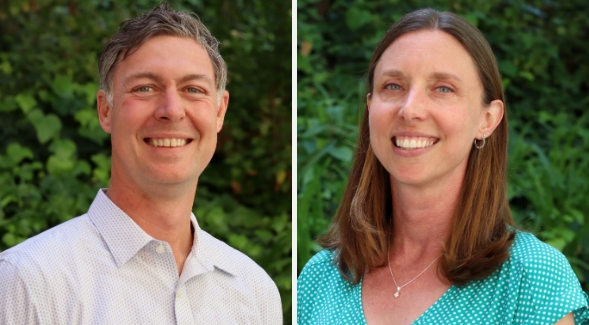Two SDSU Professors Receive Funding For Project Aimed at Reducing Graduation Equity Gaps
Psychology professors Dustin Thoman and Allison Vaughn awarded a CSU-wide grant to help faculty support students' motivation in STEM classes.

When you’re driving around an unfamiliar place, feeling a bit lost, confused and stressed about where you’re meant to go, you likely depend on a GPS for directions.
Now imagine that unfamiliar place is a college-level math class and you’re a student who has previously felt unwelcome or struggled in STEM subjects; where do you turn when facing a challenge?
“In education, we often think that it’s the student’s job to be motivated,” said San Diego State University social psychologist Dustin Thoman. “But really, motivation is determined by the person as well as the context.”
Thoman and his colleague, fellow SDSU psychology professor Allison Vaughn, have been collaborating with Motivate Lab, an educational psychology research group, to train faculty and teaching assistants at five California State University campuses how to change the classroom environment to encourage students’ motivation and persistence in psychology, chemistry and biology courses.
“We drive home three key principles about motivation with the handy acronym GPS: maintaining a growth mindset, feeling like the course has purpose and relevance, and feeling a sense of belonging,” he said.
They can now expand this training to lower division math courses after being named just one of five projects selected for the CSU-wide Creating Responsive, Equitable, Active Teaching and Engagement (CREATE) program, funded by the College Futures Foundation.
The SDSU team, along with their partners at Cal Poly Pomona and the Motivate Lab, will receive $175,000 in addition to a previous College Futures Foundation grant of $225,000 the psychology professors received for their earlier work in 2021.
The CREATE program financially supports efforts to meet the Graduation Initiative 2025 goals of reducing gaps in graduation rates and prioritizing “success for all students, including those from underserved communities and who have been historically underrepresented in higher education.”
“For me, it is really exciting to get to speed up our work to some extent. Training faculty and changing institutions can be really slow,” Thoman said. “Starting in the fall, there’s potentially thousands of students that can benefit from this work.”
Why set sights on math?
Focusing on math courses is essential to equalize graduation rates because they are often prerequisites for upper division requirements in STEM majors.
“We were always looking to leverage high-impact lower division courses with equity gaps,” Vaughn said.
If students struggle in one of the very first math courses, it can lead to a bottleneck and delay time to graduation.
“It’s like a really bad traffic jam,” said Vaughn, also the associate director for SDSU’s Center for Teaching and Learning. “We want to get in there and unstick them.”
Vaughn and Thoman will collaborate closely with San Diego State’s Department of Mathematics & Statistics, which has already implemented many active learning practices across introductory math courses.
Mike O’Sullivan, chair of SDSU’s Department of Mathematics and Statistics, said “The Department has put a lot of work into the Calculus program. Each course is tightly coordinated to ensure students encounter the same student learning outcomes, independent of the instructor or the semester. Teaching assistants receive extensive training before the semester starts and during the academic year.”
“The Motivating Learners program, with its focus on how the classroom environment affects student motivation, will be a good addition to our instructor preparation," O’Sullivan said.
“It’s been great to have campus-wide support; the College of Sciences, the Department of Psychology, and the university are all excited about it,” Vaughn said.
Shifting the gears of culture
“In our culture, we often think of motivation as a personal issue or an on/off switch. But if we look at our own lives, we know that’s not true. There are tasks in my own job that I procrastinate on and am not motivated to do,” Thoman said.
Some faculty are already taking the recommended student-centered approach because they figured it out on their own, Vaughn said.
“There is lots of data that variability in faculty mindsets and beliefs lead to different student outcomes,” Thoman said.
This training is more about giving instructors common language and the body of research behind it.
“We’re aiming for a cultural shift in pedagogy that supports student motivation. If we start seeing the same kinds of supports in multiple classes and departments and if everyone is on board, this becomes the new natural way of teaching,” Thoman said.
Instructors interested in participating in the training can sign up online, which is offered free to faculty at SDSU.



